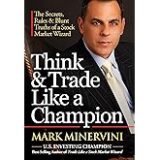This is the sixth article of Mark Minervini’s Growth Stock Investment series.
If you missed the previous article, please read it from the link below.





For more information on Minervini’s investment method, please actually purchase a book and chew it firmly.


Exit Point
In this article, I will introduce the exit point among the five major elements of Mr. Minervini’s growth stock investment method “SEPA”.
Minervini says that in order to be consistently profitable, you need to protect your profits and your principal.
The bigger the loss, the harder it is to get it back, so you should never lose enough money to endanger your account funds.

To summarize the points, it is the most important to stop loss and protect your assets. The average loss should be 6-7%, and at worst it should never exceed 10%! Also, use the magic of compounding!
Stop-Loss
Regarding the exit point, Minervini emphasizes the importance of setting a stop-loss, protecting assets above all else.
It often happens that an amateur is lucky and makes a big profit, but it is difficult to continue, and in some cases, the assets are greatly reduced or in the worst case scenario, debt is incurred.
What I found interesting is that we needed more profit to recover the loss.
For example, if the stock price drops 50% from $100 to $50, the stock price needs to rise 100% to return to zero profit and loss, and double the rate of increase to recover the 50% loss.
Therefore, it is important to keep the loss small and never to inflate it.
Minervini specifically states that losses should never exceed 10%, and average losses should be much lower, around 6-7%.
You can’t control how much the stock price will rise, but you can control the loss by yourself.
As the saying goes, the winning horse never returns to the gate, so once you start losing money, make sure you realize that you bought the stock at a wrong point.
Profit-Taking Selling
If the stock price rises as planned, Minervini says the stop-loss order should be raised to the break-even point or a trailing stop should be used to secure most profits.
Minervini also recommends keeping average profit at least twice the average loss.
By doing this, even a one-third win rate will not lead to trouble.
What I found interesting about the profit taking explanation was that when we buy and hold a stock, it explains that we should think it as a short-term date instead of marrying the stock we own.
As explained in the trend article, all stocks have four trend stages, and even stocks that have continued to rise tremendously will eventually enter a downtrend.
It is desirable not to get divorced once the marriage is done, but when it comes to investing, if you find a better stock with a short-term date feeling, it is important to move the funds there.
Compounding Magic
What I was fascinated to Minervini’s explanation is that you don’t necessarily have to invest in a tremendously rising stock to get big returns.
Of course, it is better to invest in such stocks, but you can also achieve exceptional performance by steadily generating relatively small profits and snowballing the compounding profits.
For example, if you have an initial investment of $10,000 and you are lucky or able to invest in a stock that has an amazing performance of 150% profit margin in one year, your investment will be $25,000 (= $10,000 x (150% + 100%)).
On the other hand, the profit margin at one time is only 10%, but if you discover such a stock every month and you can make a good result, the asset after 12 months with compounding magic will be $31,384 (= $10,000 x (10% + 100%)^12), which means that we can achieve better results with the monthly small profits than the one time big profit margin of 150%.



コメント